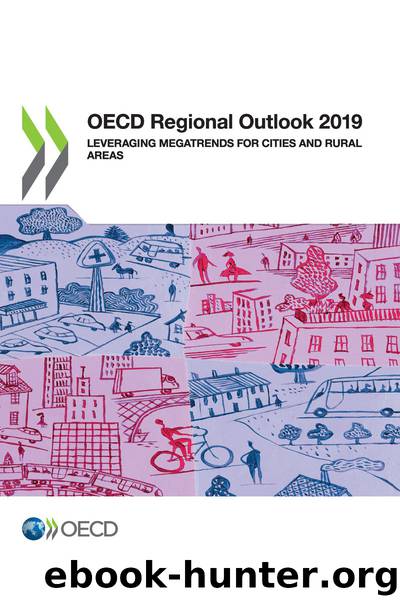OECD Regional Outlook 2019 by OECD

Author:OECD
Language: eng
Format: epub
Tags: regions
Publisher: OECD Publishing
Published: 2019-03-19T00:00:00+00:00
Global urbanisation
Domestic population flows are an important factor behind the uneven demographic development of regions. As discussed, the lower old-age dependency ratio in cities is primarily due to the domestic migration of young people into cities. However, rural-urban migration does not just affect the age profiles of cities and rural areas; the growth of cities is a global megatrend in itself that affects countries both inside and outside of the OECD.
As rapid population growth in many countries continues, understanding the process of urbanisation is essential to the design of policies to make “cities and human settlements inclusive, safe, resilient, and sustainable” in support of Sustainable Development Goal 11. Innovative policies and solutions are required to address the needs of urban populations, including housing, energy, environmental quality, healthcare and transportation. Further, smart investments in infrastructure and education are essential to promote inclusive growth, access to employment, and a safe and healthy environment.
This section previews the forthcoming analyses of a new, representative data set of all cities globally that will allow an unprecedented description of the dynamics of global urbanisation.2 It shows that recent decades have seen a strong increase in the number of people living in megacities with more than 10 million inhabitants. However, driven by overall global population growth, also the number of smaller cities with between 100 000 and 1 million inhabitants grew rapidly. Yet, the section highlights that, despite an overall trend towards urbanisation, a significant number of cities have shrinking population due to emigration and low fertility rates.
Table 4.1 shows that 40% of the world’s population lived in cities with more than 100 000 inhabitants in 2015. The vast majority of these cities (97%) have fewer than 1 million people. However, cities with more than 1 million inhabitants have a larger population share. Close to 1.62 billion people live in cities with more than 1 million inhabitants. Among them, a third (530 million people) live in cities with more than 10 million inhabitants. In contrast, only 1.33 billion people live in cities with 100 000 to 1 million inhabitants. Nevertheless, this impressive number shows the importance of mid-sized cities.
Download
This site does not store any files on its server. We only index and link to content provided by other sites. Please contact the content providers to delete copyright contents if any and email us, we'll remove relevant links or contents immediately.
International Integration of the Brazilian Economy by Elias C. Grivoyannis(75012)
The Radium Girls by Kate Moore(11621)
Turbulence by E. J. Noyes(7702)
Nudge - Improving Decisions about Health, Wealth, and Happiness by Thaler Sunstein(7244)
The Black Swan by Nassim Nicholas Taleb(6770)
Rich Dad Poor Dad by Robert T. Kiyosaki(6179)
Pioneering Portfolio Management by David F. Swensen(6081)
Man-made Catastrophes and Risk Information Concealment by Dmitry Chernov & Didier Sornette(5650)
Zero to One by Peter Thiel(5494)
Secrecy World by Jake Bernstein(4389)
Millionaire: The Philanderer, Gambler, and Duelist Who Invented Modern Finance by Janet Gleeson(4099)
The Age of Surveillance Capitalism by Shoshana Zuboff(3989)
Skin in the Game by Nassim Nicholas Taleb(3968)
The Money Culture by Michael Lewis(3849)
Bullshit Jobs by David Graeber(3833)
Skin in the Game: Hidden Asymmetries in Daily Life by Nassim Nicholas Taleb(3724)
The Dhandho Investor by Mohnish Pabrai(3561)
The Wisdom of Finance by Mihir Desai(3526)
Blockchain Basics by Daniel Drescher(3330)
